Rob Arndt
2010-08-06 18:07:10 UTC
SSW Gleiterbombe or gleitertorpedo:
Loading Image...
Loading Image...
Loading Image...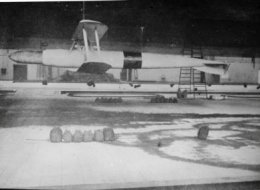
Loading Image...
20mm Becker cannon:
Loading Image...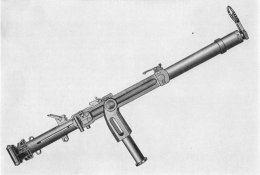
Loading Image...
Becker Cannon
When the leaders of the German Air Force, during the latter days of
the first World War, ordered the placing of armor around the vital
parts of their huge Gotha bombing planes, they realized that they had
not only made, the rifle-caliber machine guns of the Allies obsolete
but their own as well. In order to find some suitable weapon that
would deal adequately with the situation and still not violate the St.
Petersburg Treaty relating to small-bore explosive projectiles, they
turned to the invention of Reinhold Becker, of Krefeld, Germany, who
was then producing an aircraft cannon at his own firm, the Becker
Stahlwerke at Willich am Rhein. His patent had been applied for in
1914.
The 20-mm Becker cannon was extremely light in weight, magazine fed
and used straight blow-back for its operating power. It was full
automatic, with a rate of fire given as 400 rounds a minute and, when
first used by the Germans, employed a nonexploding solid projectile.
It consists principally of a barrel which is forged to trunnions that
rest in the pintle. A cylindrical receiver having a magazine latch on
top and an ejection slot in the bottom is firmly screwed to the
barrel. The rear end of the receiver is closed by a portion which
houses the sear notch and a round end block which contains the
trigger, safety, and buffer mechanism. These parts do not recoil. The
barrel is partially covered by a sliding sleeve which houses the
driving spring. This spring is seated at its rear end against a
shoulder of the barrel, and at its forward end on an adjustable
position in the shoulder of the sleeve. This in turn has at its lower
end trunnions for two side bars that connect the sleeve and the bolt.
The connection with the bolt is made by a flat key which passes all
the way through this member and projects out of each side through
slots in the receiver. The charging handles are riveted to the side
pieces. The bolt rides in its slideway in the receiver and contains
the firing pin. The latter is actuated by a bell-crank arrangement,
pivoted in the bolt, which strikes a step in the receiver during its
forward motion.
A rather unusual safety feature is embodied in the Becker. In the
chamber at the rear of the projectile but well forward of the point
where rupture is most likely to occur, a plunger passes through the
top of the chamber which bears a spring-loaded pawl at its outer end.
The case, when positioned, presses the plunger flush with the chamber
walls and the pawl is raised. If the case is ruptured or fails to
extract, the catch will engage a special hook fastened to the sleeve
when that part is in its full recoil. In this manner the gun is
stopped until the unextracted case is removed.
As another unique feature the bolt continues to move forward during
the firing of the shot by virtue of its kinetic energy. This insures
an absolutely gas-tight closure of the rear end of the barrel and a
minimum of recoil, which, after absorbing the terrific forward speed
of the heavy bolt assembly, is then only sufficient to drive the bolt
to its rearmost position. The cartridge case, while not supported by a
locked bolt, is inclosed in the chamber during the instant of
explosion and the rearwardly acting gas pressure cannot burst it.
The primer is ignited well before the bolt has reached battery
position. With this arrangement the chamber pressure acts on a member
of considerable mass which is moving forward. The energy of this fast
traveling piece must first be overcome before it can be put in recoil
movement by the exploding powder charge.
The cannon had hardly been mounted by the Germans when one of the
planes armed with it was shot down by a French fighter. There was
great excitement among Allied ordnance specialists at having such an
advanced weapon fall into their hands. Although the plane fell in
flames and all ammunition was destroyed, the gun itself, mounted
flexibly on a single yoke pintle, was salvaged and displayed to high-
ranking officers.
After the Armistice the Allies had at their disposal enough captured
ammunition to conduct a fair test of the piece. Most of this work was
done at the range of the French Puteaux Arsenal. On 31 March 1919, one
Becker automatic 20-mm aircraft cannon was brought to the Army's
Ordnance Department in Washington, D. C. This weapon was marked "2 CMM
FLZ. K.—Becker—Typ 2—1045" (the FLZ. K. meant Flugzeugkanone, or
Aircraft cannon).
The Ordnance Department did not show any interest in the cannon other
than placing it in its museum at Aberdeen, but France experimented
with the mechanism for a number of years, and the conclusions of the
board at the Puteaux Arsenal were to the effect that it was very
formidable for air combat but could not be classed as such against
tanks or heavily armored units.
Gast guns:
7.92mm
Loading Image...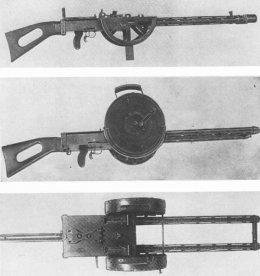
13mm
Loading Image...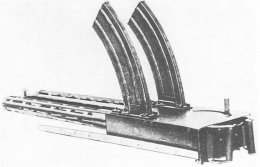
Model/Name: Gast gun, Gast-Maschinengewehr Modell 1917
Place of origin: Germany
Produced: 1916
Wars: World War I
Caliber: 7.92x57 mm Mauser, 13 mm
Rate Of Fire: 1,600 rounds/min
Barrels: 2
Mounted on: Man-portable or aircraft
The Gast Gun was a German twin barreled machine gun developed by Karl
Gast of Vorwerk und Companie of Barmen, and used during the First
World War. It was notable for its high rate of fire of 1,600 rounds
per minute and a unique mechanism that is used today in the Gryazev-
Shipunov GSh-23L series of Russian aircraft cannon.
A Gast gun was evaluated by the US Army, and found to be reliable and
mechanically practical. However it was felt that it did not offer
enough of an advantage over the existing machine guns to justify the
expense of producing the weapon.
Tromix have recently brought experimented with the design with what
they call the "Siamese .223", two M16's rigged together using the Gast
firing principal - it is being marketted to US law enforcement.
Motorgewehr:
Re-post:
Loading Image...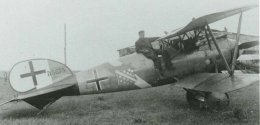
Loading Image...
Loading Image...
Loading Image...
Jasta 58 Albatros D.Va with Siemens motor-driven guns- 1,400 rpm!!!
Some operational Pfalz D.XIIs were also fitted with the guns, but were
instructed to stay within German lines to prevent the aircraft from
falling into Allied hands.
In addition, Aerogen, Wollerman, and Fokker built motorguns too.
Fokker's 12 barrel motorgun reached 7,200 rpm in WW1- more than the
modern Vulcan. Only one prototype was built, but the design was
patented after WW1 and then nothing after that.
So it is actually incorrect to say that the Germans had the a/c
revolver cannon in WW2 with the MK-213- they had them in WW1 as
well :)
Rob
p.s. Hungarian Gabauer motorgun was also in use in WW1:
http://www.sunblest.net/gun/Gebauer.htm
Remote-Controlled Aircraft:
There were 5 Albatros unmanned conversions to be used as weapons, but
I have never seen a photo of them.
Rob
Loading Image...
Loading Image...
Loading Image...
Loading Image...
20mm Becker cannon:
Loading Image...
Loading Image...
Becker Cannon
When the leaders of the German Air Force, during the latter days of
the first World War, ordered the placing of armor around the vital
parts of their huge Gotha bombing planes, they realized that they had
not only made, the rifle-caliber machine guns of the Allies obsolete
but their own as well. In order to find some suitable weapon that
would deal adequately with the situation and still not violate the St.
Petersburg Treaty relating to small-bore explosive projectiles, they
turned to the invention of Reinhold Becker, of Krefeld, Germany, who
was then producing an aircraft cannon at his own firm, the Becker
Stahlwerke at Willich am Rhein. His patent had been applied for in
1914.
The 20-mm Becker cannon was extremely light in weight, magazine fed
and used straight blow-back for its operating power. It was full
automatic, with a rate of fire given as 400 rounds a minute and, when
first used by the Germans, employed a nonexploding solid projectile.
It consists principally of a barrel which is forged to trunnions that
rest in the pintle. A cylindrical receiver having a magazine latch on
top and an ejection slot in the bottom is firmly screwed to the
barrel. The rear end of the receiver is closed by a portion which
houses the sear notch and a round end block which contains the
trigger, safety, and buffer mechanism. These parts do not recoil. The
barrel is partially covered by a sliding sleeve which houses the
driving spring. This spring is seated at its rear end against a
shoulder of the barrel, and at its forward end on an adjustable
position in the shoulder of the sleeve. This in turn has at its lower
end trunnions for two side bars that connect the sleeve and the bolt.
The connection with the bolt is made by a flat key which passes all
the way through this member and projects out of each side through
slots in the receiver. The charging handles are riveted to the side
pieces. The bolt rides in its slideway in the receiver and contains
the firing pin. The latter is actuated by a bell-crank arrangement,
pivoted in the bolt, which strikes a step in the receiver during its
forward motion.
A rather unusual safety feature is embodied in the Becker. In the
chamber at the rear of the projectile but well forward of the point
where rupture is most likely to occur, a plunger passes through the
top of the chamber which bears a spring-loaded pawl at its outer end.
The case, when positioned, presses the plunger flush with the chamber
walls and the pawl is raised. If the case is ruptured or fails to
extract, the catch will engage a special hook fastened to the sleeve
when that part is in its full recoil. In this manner the gun is
stopped until the unextracted case is removed.
As another unique feature the bolt continues to move forward during
the firing of the shot by virtue of its kinetic energy. This insures
an absolutely gas-tight closure of the rear end of the barrel and a
minimum of recoil, which, after absorbing the terrific forward speed
of the heavy bolt assembly, is then only sufficient to drive the bolt
to its rearmost position. The cartridge case, while not supported by a
locked bolt, is inclosed in the chamber during the instant of
explosion and the rearwardly acting gas pressure cannot burst it.
The primer is ignited well before the bolt has reached battery
position. With this arrangement the chamber pressure acts on a member
of considerable mass which is moving forward. The energy of this fast
traveling piece must first be overcome before it can be put in recoil
movement by the exploding powder charge.
The cannon had hardly been mounted by the Germans when one of the
planes armed with it was shot down by a French fighter. There was
great excitement among Allied ordnance specialists at having such an
advanced weapon fall into their hands. Although the plane fell in
flames and all ammunition was destroyed, the gun itself, mounted
flexibly on a single yoke pintle, was salvaged and displayed to high-
ranking officers.
After the Armistice the Allies had at their disposal enough captured
ammunition to conduct a fair test of the piece. Most of this work was
done at the range of the French Puteaux Arsenal. On 31 March 1919, one
Becker automatic 20-mm aircraft cannon was brought to the Army's
Ordnance Department in Washington, D. C. This weapon was marked "2 CMM
FLZ. K.—Becker—Typ 2—1045" (the FLZ. K. meant Flugzeugkanone, or
Aircraft cannon).
The Ordnance Department did not show any interest in the cannon other
than placing it in its museum at Aberdeen, but France experimented
with the mechanism for a number of years, and the conclusions of the
board at the Puteaux Arsenal were to the effect that it was very
formidable for air combat but could not be classed as such against
tanks or heavily armored units.
Gast guns:
7.92mm
Loading Image...
13mm
Loading Image...
Model/Name: Gast gun, Gast-Maschinengewehr Modell 1917
Place of origin: Germany
Produced: 1916
Wars: World War I
Caliber: 7.92x57 mm Mauser, 13 mm
Rate Of Fire: 1,600 rounds/min
Barrels: 2
Mounted on: Man-portable or aircraft
The Gast Gun was a German twin barreled machine gun developed by Karl
Gast of Vorwerk und Companie of Barmen, and used during the First
World War. It was notable for its high rate of fire of 1,600 rounds
per minute and a unique mechanism that is used today in the Gryazev-
Shipunov GSh-23L series of Russian aircraft cannon.
A Gast gun was evaluated by the US Army, and found to be reliable and
mechanically practical. However it was felt that it did not offer
enough of an advantage over the existing machine guns to justify the
expense of producing the weapon.
Tromix have recently brought experimented with the design with what
they call the "Siamese .223", two M16's rigged together using the Gast
firing principal - it is being marketted to US law enforcement.
Motorgewehr:
Re-post:
Loading Image...
Loading Image...
Loading Image...
Loading Image...
Jasta 58 Albatros D.Va with Siemens motor-driven guns- 1,400 rpm!!!
Some operational Pfalz D.XIIs were also fitted with the guns, but were
instructed to stay within German lines to prevent the aircraft from
falling into Allied hands.
In addition, Aerogen, Wollerman, and Fokker built motorguns too.
Fokker's 12 barrel motorgun reached 7,200 rpm in WW1- more than the
modern Vulcan. Only one prototype was built, but the design was
patented after WW1 and then nothing after that.
So it is actually incorrect to say that the Germans had the a/c
revolver cannon in WW2 with the MK-213- they had them in WW1 as
well :)
Rob
p.s. Hungarian Gabauer motorgun was also in use in WW1:
http://www.sunblest.net/gun/Gebauer.htm
Remote-Controlled Aircraft:
There were 5 Albatros unmanned conversions to be used as weapons, but
I have never seen a photo of them.
Rob